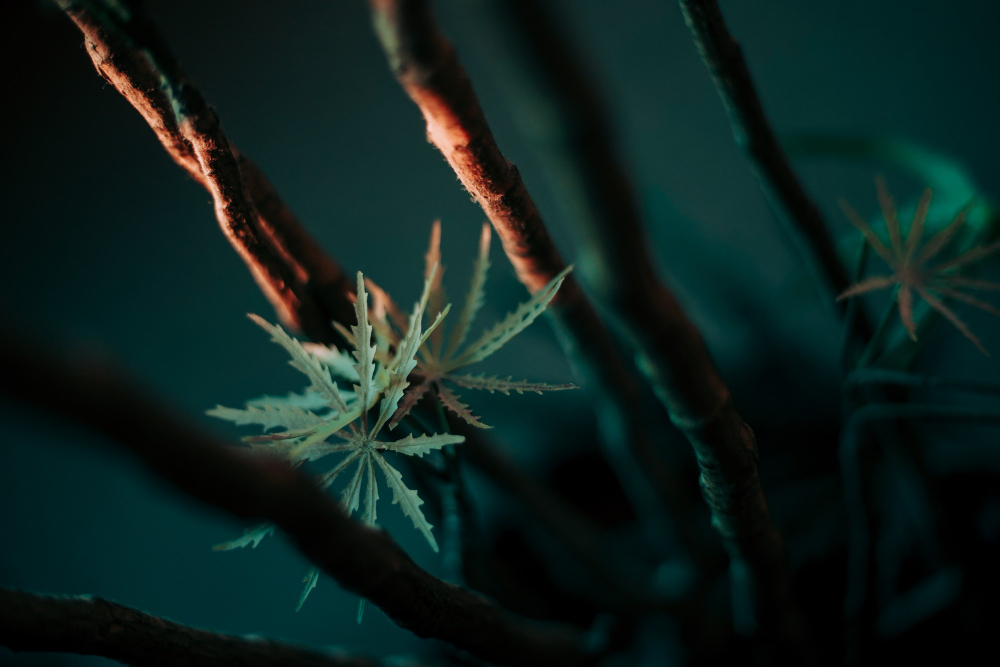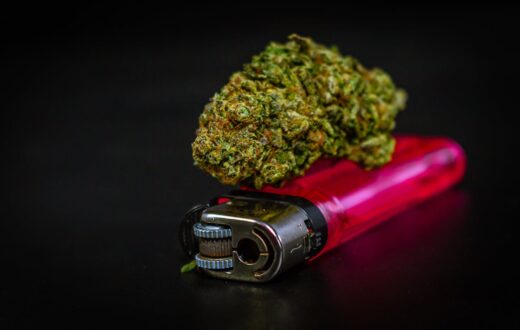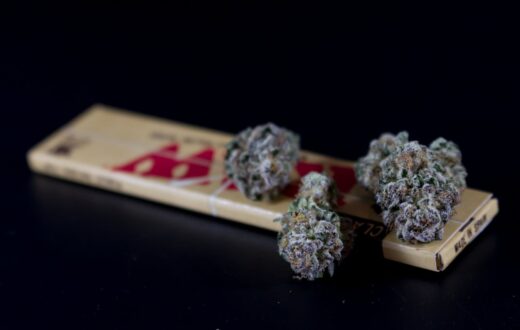Introduction to Blue Dream
Blue Dream is a hybrid cannabis strain that has gained significant popularity among cannabis enthusiasts and cultivators alike. Originally bred in California, Blue Dream is a cross between the sativa Haze and the indica Blueberry. This strain is renowned for its balanced effects, delivering a gentle wave of euphoria combined with relaxing sensations, making it a preferred choice for both recreational and medicinal users. Its distinctive flavor profile, which features sweet berry notes accompanied by hints of earthiness, adds to its allure.
The Blue Dream strain’s appeal is amplified by its high-yield potential, often resulting in abundant harvests, particularly when cultivated outdoors. Cannabis growers in South Africa have increasingly turned to this strain, as it thrives in various climates and soil types. With its resilience to environmental stressors and ability to adapt, Blue Dream has become a staple among those looking to maximize their outdoor cultivation efforts.
Another aspect that contributes to Blue Dream’s popularity is its relatively easy growth process. Even novice growers have reported success with this strain, as it does not require overly complicated techniques to achieve optimal results. When nurtured under the right conditions with sufficient sunlight, Blue Dream plants can grow tall and bushy, producing substantial amounts of buds. This makes it an ideal choice for outdoor growing in regions like South Africa, where favorable weather conditions can lead to even higher yields.
In summary, Blue Dream stands out in the cannabis community not only for its exceptional flavor and balanced effects but also for its suitability for outdoor cultivation. Its high-yield capabilities make it an attractive option for growers seeking to capitalize on their cannabis production, ensuring that it remains a favored strain among both experienced and new growers alike.
Understanding the South African Climate
To successfully engage in growing outdoor South Africa Blue Dream, it is crucial to comprehend the unique climate characteristics of the region. South Africa is known for its diverse climate zones, which play a significant role in the cultivation of cannabis. Typically, the climate can be categorized into semi-arid, Mediterranean, and subtropical variations, each possessing distinct temperature ranges and seasonal changes.
Temperature is a vital aspect of cannabis farming. In regions such as the Western Cape, summer temperatures can soar above 30 degrees Celsius, while winters often dip to around 5 degrees Celsius. For optimum growth of Blue Dream, the ideal temperature range is between 20 to 30 degrees Celsius during the day. This temperature ensures that plants can produce strong buds and healthy yields while avoiding stress from extreme heat or frost.
Sunlight availability is another critical factor in the growing process. South Africa enjoys an abundance of sunshine throughout the year, with longer photoperiods during the summer months, which is beneficial for flowering. Strategically planning planting times around the seasonal changes ensures that growers can maximize light exposure when nurturing Blue Dream outdoors. Generally, planting in early spring allows for the most extended growth period which also coincides with the peak sunlight hours.
Precipitation levels also vary across the country, impacting water availability for cannabis plants. While some areas might receive ample rainfall, others are more arid. A thorough understanding of local rainfall patterns will assist in determining appropriate watering schedules, which is particularly vital considering that Blue Dream thrives in well-drained soil. Ultimately, by acknowledging the South African climate’s nuances, growers can optimize the conditions for cultivating high-yield cannabis varieties like Blue Dream, ensuring a fruitful harvest.
Choosing the Right Location
When it comes to growing outdoor South Africa Blue Dream, selecting the right location is paramount for achieving optimal growth and high yields. The environment in which cannabis plants are cultivated plays a critical role in their development, directly impacting the plant’s health, potency, and overall yield. Several factors need careful consideration before deciding on the perfect spot.
First and foremost, soil quality is essential. Blue Dream thrives in well-aerated, nutrient-rich soil. Conducting a soil test prior to planting can provide insight into nutrient levels and pH balance. Ideal soil conditions should range from 6.0 to 7.0 pH. If the soil is lacking in essential nutrients, you can amend it with organic matter such as compost or well-rotted manure, which not only enrich the soil but also improve drainage.
Drainage is another critical factor when growing outdoor South Africa Blue Dream. Cannabis plants dislike waterlogged roots, which can lead to root rot and other diseases. Choose a location that allows excess water to drain away quickly. Raised beds or slightly elevated plots can enhance drainage and soil temperature, which are vital for healthy growth.
Moreover, proximity to sunlight cannot be overlooked. Blue Dream requires at least six to eight hours of direct sunlight daily to maximize photosynthesis and yield. When selecting a site, ensure that it is unobstructed by tall trees or buildings that may cast shadows over the plants. Lastly, consider wind protection; strong winds can damage plants and disrupt their growth cycle. Planting natural windbreaks, such as hedges or fences, can help safeguard your crop while providing a suitable microclimate.
By carefully considering soil quality, drainage, sunlight exposure, and wind protection, growers can create an ideal environment for cultivating outdoor South Africa Blue Dream, setting the stage for a successful harvest.
Preparing the Soil for Planting
When embarking on the journey of growing outdoor South Africa Blue Dream, the foundation of your success lies in the soil health and its composition. A comprehensive understanding of soil testing is crucial, as it allows growers to gauge the nutrient profile and pH levels of their planting medium. Before planting Blue Dream, it is advisable to collect soil samples from the intended growing area. Testing kits, available through agricultural supply stores, can reveal vital information regarding nitrogen, phosphorus, potassium, and other essential nutrients, helping to determine the necessary amendments for optimal growth.
Once you have analyzed the soil, you may find that it requires adjustments to achieve the ideal conditions for growing outdoor South Africa Blue Dream. Incorporating organic amendments like compost can greatly enhance soil structure, improve drainage, and boost the presence of beneficial microorganisms. Compost not only provides nutrients but also increases the soil’s water-retention capacity—an essential factor for sustaining healthy cannabis plants. Additionally, fertilizers may be required to replenish specific deficiencies highlighted by your soil tests, ensuring that your Blue Dream plants have all the necessary nourishment to thrive.
Creating the perfect soil mix for Blue Dream also involves considering the drainage and aeration properties of the soil. A well-aerated soil mixture encourages healthy root development, which is vital for optimal growth and high yields. A common recommendation is to combine native soil with equal parts of compost and perlite or sand. This blend promotes drainage while maintaining moisture levels suitable for the thriving cannabis plant. Ultimately, a tailored approach to soil preparation will set the stage for a successful growing season, enhancing the potential yields of South Africa Blue Dream and ensuring that your plants flourish in their outdoor environment.
Germination and Seedling Care
Successfully germinating Blue Dream seeds is a crucial first step in the journey of growing outdoor South Africa Blue Dream. The selection of high-quality seeds is paramount; it is advisable to source them from reputable seed banks known for their genetics. Look for seeds that are firm, dark in color, and have a shiny surface, which are typically indicators of viability.
There are several germination methods that can be employed, with the paper towel technique being one of the most popular among growers. To utilize this method, take two damp paper towels, place the seeds between them, and then enclose them in a plastic container to maintain humidity. Check the seeds regularly, and once the taproot is approximately half an inch long, it is time to transfer them to soil. An alternative method is to directly plant the seeds in moist soil. For growing outdoor South Africa Blue Dream, ensure that the soil is well-draining and enriched with organic matter.
After the seeds have successfully germinated, the attention shifts to seedling care. During this crucial stage, it is essential to maintain a warm temperature range of 20-25°C (68-77°F). Seedlings should be provided with adequate light; for outdoor cultivation, placing them in a location where they receive at least six hours of sunlight daily is beneficial. Watering is equally important; the soil should be kept moist but not waterlogged to avoid root rot. Fertilization should be minimal at this roote stage but consider using a diluted, balanced nutrient solution to support early growth. Regular monitoring for pests and diseases is also essential as a proactive approach helps nurture robust Blue Dream plants that mature into high-yield specimens.
Cultivation Techniques for Maximum Yield
When it comes to cultivating Blue Dream outdoors in South Africa, employing effective techniques can significantly enhance your yield. Among the most beneficial practices are topping, training, and pruning, each contributing to a healthier plant and higher output.
Topping is the process of trimming the main shoot of the plant, which encourages the growth of lateral branches. This technique allows the plant to become bushier, increasing the number of colas that produce buds. For Blue Dream, topping can lead to a greater yield by effectively utilizing the sunlight that South Africa’s climate provides. This method is best performed during the early stages of vegetative growth, allowing ample time for the plant to recover and develop strong secondary stems.
Training techniques, such as Low Stress Training (LST) and High Stress Training (HST), also play a crucial role in maximizing the potential of outdoor Blue Dream crops. LST involves gently bending and securing branches to create a more even canopy, which enhances light exposure. HST, on the other hand, involves more rigorous techniques like super cropping, which entails breaking the inner stem tissue to promote healing and growth. Both practices lead to better nutrient distribution across the plant, thereby increasing the overall yield.
Pruning further supports the health and productivity of Blue Dream. This technique includes removing dead or unhealthy leaves and branches, allowing for better airflow and light penetration. Healthy plants are less susceptible to pests and diseases, which is essential for growers in South Africa’s climate. By regularly pruning your outdoor cannabis plants, you can ensure that they remain productive and vibrant.
In summary, combining these cultivation techniques—topping, training, and pruning—while nurturing your outdoor South Africa Blue Dream will lead to notable improvements in yield and overall plant health.
Managing Nutrients and Watering
Effective management of nutrients and watering is critical for healthy growth and optimal yields when growing outdoor South Africa Blue Dream cannabis. This strain is renowned for its high yield and exceptional quality; thus, understanding its nutrient needs is vital to achieving successful cultivation results. During the vegetative stage, Blue Dream benefits from nutrient-rich fertilizers that promote strong root development and vigorous growth. A balanced fertilizer that includes nitrogen, phosphorus, and potassium (NPK) in appropriate ratios will support these early growth phases.
As the plant transitions into the flowering stage, the nutrient requirements shift. At this point, it is essential to reduce nitrogen levels while increasing phosphorus and potassium to enhance bud development and potency. Many growers opt for bloom-specific formulations that are tailored to meet these evolving needs of the Blue Dream plant. Additionally, incorporating organic amendments, such as compost or worm castings, can provide essential micronutrients and support soil health throughout the growth cycle.
Watering is equally important in managing the health of growing outdoor South Africa Blue Dream cannabis. Proper hydration regulates plant metabolism, nutrient uptake, and overall wellbeing. During the early stages, young plants require consistent moisture, but it is crucial to avoid over-watering, which can lead to root rot and other issues. As plants mature, an established watering schedule that allows the top layer of soil to dry between waterings can promote strong root growth and prevent potential diseases.
Implementing a soil moisture monitoring system can assist growers in aligning their watering practices with the specific needs of Blue Dream plants. Keeping track of moisture levels helps in making informed decisions regarding water applications and nutrient delivery. By mastering the balance of water and essential nutrients, cultivators can maximize the potential of their Blue Dream crops, ultimately leading to a bountiful harvest.
Pest and Disease Prevention
When growing outdoor South Africa Blue Dream, effective pest and disease prevention is essential to ensure that these plants reach their full potential. Cannabis crops are susceptible to a variety of common pests such as aphids, spider mites, and whiteflies, as well as diseases like powdery mildew and root rot. The first line of defense is to establish a thorough monitoring system to detect any signs of infestation or disease early on. Regularly inspecting your plants, especially the undersides of leaves and the soil, allows for timely intervention, which can significantly reduce damage.
One of the most effective strategies for managing pests organically is through the use of beneficial insects. Ladybugs and lacewings are natural predators that can control aphid populations, while predatory mites can keep spider mites at bay. Additionally, integrating companion planting techniques can create a balanced ecosystem. For instance, planting marigolds can deter certain harmful insects, ultimately promoting a healthier environment for your outdoor South Africa Blue Dream plants.
It is also crucial to maintain optimal growing conditions, as this reduces the risk of disease. Proper air circulation, adequate spacing between plants, and the avoidance of overhead watering can limit the development of mold and mildew. In cases where prevention measures are not sufficient, growers should consider using organic fungicides or insecticides as a last resort to mitigate infestations or outbreaks.
Implementing these natural pest control strategies, coupled with vigilance and appropriate cultural practices, provides cannabis growers with a robust framework to protect their outdoor South Africa Blue Dream crops. With a proactive approach, you can minimize the risks associated with pests and diseases while maximizing the yield and quality of your harvest.
Harvesting and Post-Harvest Processing
Harvesting Blue Dream, particularly in the outdoor setting of South Africa, is a critical phase that influences both yield and quality. Identifying the right time to harvest is essential for maximizing the plant’s potential. Growers should observe the trichomes on the buds with a magnifying glass; a change in color from clear to milky white indicates that the plant is nearing optimal harvest time. When approximately 20% of the trichomes turn amber, the plant has reached peak potency, making this an ideal harvesting window.
When ready, it is important to harvest the plants carefully to minimize damage. Begin by cutting the branches from the main stalk with sharp pruning shears, ensuring a clean cut to avoid any jagged edges. Handling should be done gently to prevent bruising the delicate flowers. It is advisable to harvest during the cooler parts of the day, either early morning or late afternoon. This timing helps preserve the plant’s essential oils and cannabinoids, both crucial for the flavor and potency of the final product.
Following the harvesting process, growers must focus on post-harvest processing to ensure the preservation of their yield. Drying is the first step, requiring a cool, dark, and well-ventilated area. Hanging the cut branches upside down allows for an even drying process, usually taking about a week. After drying, curing the cannabis in glass jars will enhance the flavor profile and potency. The jars should be opened daily to allow moisture escape, ensuring that the buds cure thoroughly without molding. Proper storage in a cool, dark environment will protect the cannabis from degradation over time, allowing growers to enjoy their high-quality Blue Dream for months. By adhering to these guidelines, those involved in growing outdoor South Africa Blue Dream can harvest and process their plants effectively, maximizing their yield and product quality.














